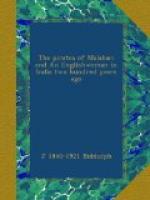If Every had been in his place, he would have followed the fleet across the Indian Ocean, and have picked up a straggler or two, but the sight of the Sceptre and a Dutch man-of-war had been enough for Kidd, and he left the pilgrim fleet alone. Without molesting them further, he made his way eastward, and, on the 29th August, off Sanjan, north of Bombay, he took the Mary brigantine, a small native vessel from Surat. This was Kidd’s first capture on the high seas. Thomas Parker, the master of the Mary, was forced on board the Adventure to act as pilot, a Portuguese was taken to act as interpreter, and the lascars of the Mary beaten and ill-treated. A week later he put into Carwar for provisions, flying English colours; but his character was already known. The Sunda Rajah and the factory stood on their guard while he was in harbour. Harvey, the chief of the factory, demanded the surrender of Parker, but Kidd vowed he knew nothing about him. Eight of his crew deserted, and told their story. They had no desire for the piratical life into which they had been trepanned, and reported that many more of the crew would leave him if they could get the chance. While off Carwar he careened the Adventure on a small islet in the harbour, which was long known as Kidd’s island. A month later he was off Calicut, where his ever-recurring trouble about supplies is shown in the following letter to the factory:—
“Adventure Gally, October y’e 4’t, 1697.
“S’r,
“I can’t but admire y’t y’r People is so fearfull to come near us for I have used all possible means to let them understand y’t I am an Englishman and a ff’rd not offering to molest any of their Cannoes so think it convenient to write this y’t you may understand whome I am which (I) hope may end all Suspition. I come from England about 15 mos. agone with y’e King’s Commission to take all Pyrates in these seas, and from Carwar came ab’t a month agone, so do believe y’t (you) have heard whome I am before y’t and all I come for here is wood and water wh’h if you will be pleas’d to order me shall honestly satisfie for y’e same or any thing that they’l bring off which is all from him who will be very ready to serve you in what lyeth in my Power.
“WILLIAM KIDD.”
They knew who he was only too well, so he sailed for the Laccadives, whence news was soon received of his barbarous treatment of the natives, and that he had killed his quartermaster.[2] The letter is characteristic of Kidd’s methods. From his first entrance into the Indian seas his conduct had aroused suspicion. Owing to the large amount of coasting trade and the frequent necessity of calling at many places for water, the news of the sea spread from port to port with great rapidity. At the moment of his writing this letter he had the master of the Mary a prisoner under hatches, and the factory chiefs of Carwar and Calicut were well aware of it; but to the end he believed that he could throw dust in the eyes of the Company’s officials by making play with the royal commission.




